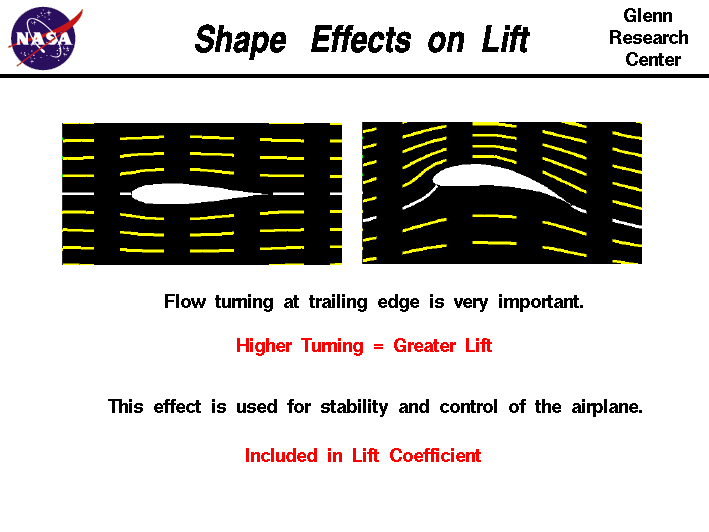
Airfoils are also found in propellers, fans, compressors and turbines. The wings and stabilizers of fixed-wing aircraft, as well as helicopter rotor blades, are built with airfoil-shaped cross sections. Lift and drag curves for a typical airfoil

inviscid potential flow) the lift force can be related directly to the average top/bottom velocity difference without computing the pressure by using the concept of circulation and the Kutta–Joukowski theorem. This pressure difference is accompanied by a velocity difference, via Bernoulli's principle, so the resulting flowfield about the airfoil has a higher average velocity on the upper surface than on the lower surface.

This "turning" of the air in the vicinity of the airfoil creates curved streamlines, resulting in lower pressure on one side and higher pressure on the other. Most foil shapes require a positive angle of attack to generate lift, but cambered airfoils can generate lift at zero angle of attack. This force is known as aerodynamic force and can be resolved into two components: lift and drag. When oriented at a suitable angle, the airfoil deflects the oncoming air (for fixed-wing aircraft, a downward force), resulting in a force on the airfoil in the direction opposite to the deflection. The lift on an airfoil is primarily the result of its angle of attack. Foils of similar function designed with water as the working fluid are called hydrofoils. Airfoils designed for use at different speeds differ in their geometry: those for subsonic flight generally have a rounded leading edge, while those designed for supersonic flight tend to be slimmer with a sharp leading edge. An airfoil is a streamlined shape that is capable of generating significantly more lift than drag. The component parallel to the relative freestream velocity is called drag.

The component of this force perpendicular to the relative freestream velocity is called lift. Streamlines on an airfoil visualised with smoke wind tunnelĪn airfoil ( American English) or aerofoil ( British English) is the cross-sectional shape of an object whose motion through a gas is capable of generating significant lift, such as a wing, a sail, or the blades of propeller, rotor, or turbine.Ī solid body moving through a fluid produces an aerodynamic force.


 0 kommentar(er)
0 kommentar(er)
